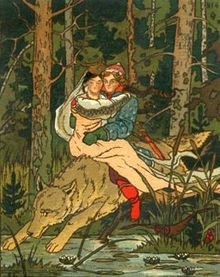
A Russian fairy tale or folktale (Russian: ска́зка; skazka; "story"; plural Russian: ска́зки, romanized: skazki) is a fairy tale from Russia.
Various sub-genres of skazka exist. A volshebnaya skazka [волше́бная ска́зка] (literally "magical tale") is considered a magical tale.[1][need quotation to verify] Skazki o zhivotnykh are tales about animals and bytovye skazki are tales about household life. These variations of skazki give the term more depth and detail different types of folktales.
Similarly to Western European traditions, especially the German-language collection published by the Brothers Grimm, Russian folklore was first collected by scholars and systematically studied in the 19th century. Russian fairy tales and folk tales were cataloged (compiled, grouped, numbered and published) by Alexander Afanasyev in his 1850s Narodnye russkie skazki. Scholars of folklore still refer to his collected texts when citing the number of a skazka plot. An exhaustive analysis of the stories, describing the stages of their plots and the classification of the characters based on their functions, was developed later, in the first half of the 20th century, by Vladimir Propp (1895-1970).
- ^ "Magic tale (volshebnaia skazka), also called fairy tale". Kononenko, Natalie (2007). Slavic Folklore: A Handbook. Greenwood Press. p. 180. ISBN 978-0-313-33610-2.
© MMXXIII Rich X Search. We shall prevail. All rights reserved. Rich X Search
